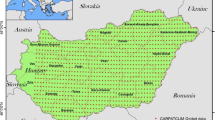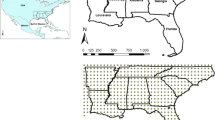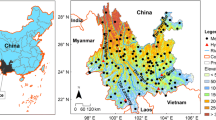Abstract
Drought events have become increasingly frequent and intensive due to the combined influence of climate change and anthropogenic activities. However, it remains unclear how meteorological drought characteristics (duration, severity, and intensity) respond to the changing environment and what are the dominant factors determining the drought evolution in different climate regions. Here, we divide mainland China into four sub-climatic regions, namely the Humid region (HR), Transition region (TR), Arid region (AR), and Tibetan Plateau (TP), based on the aridity index and geomorphology. Then systematically investigate the spatiotemporal patterns of drought characteristics in different climate regions over China (during 2000–2019) based on the SPEI and run theory. And the contribution of precipitation (Pre) and potential evapotranspiration (PET) to drought characteristics are quantitatively analyzed using a detrended numerical experiment method. We find that (1) a pattern of “dry gets drier, wet gets wetter” was found in China. (2) Meteorological drought characteristics exhibit apparent regional heterogeneity: droughts in AR are of long duration and high severity, while droughts in HR and TR show a pattern of high frequency. (3) An increase in the annual Pre (PET) resulted in increases (decreases) in average SPEI in China of 45.18% (31.62%). Therefore, Pre is the dominant factor determining the increase of SPEI over China. For the four sub-climatic regions, Pre is the dominant factor in the increase of SPEI in TR and HR, with the contribution of 41.64% and 60.16%. PET is the dominant factor in the decrease of SPEI in AR, with the contribution of 50.11%. The contributions of Pre (45.09%) and PET (44.09%) in TP are roughly equivalent. These findings provide valuable insights for policymakers in shaping climate change adaptation and mitigation strategies. By understanding the leading meteorological factors influencing drought, policymakers can implement effective measures to minimize the influence of disasters.










Similar content being viewed by others
References
Adamu M, Gallant AJ, Mcgregor S (2022) Decadal-scale variations in extreme precipitation and implications for seasonal scale drought. Clim Dyn 1–16
Allan R, Pereira L, Smith M (1998) Crop evapotranspiration-Guidelines for computing crop water requirements-FAO. Irrigation and drainage paper 56. Fao, Rome, 300(9):D05109
Bai P (2023) Comparison of remote sensing evapotranspiration models: consistency, merits, and pitfalls. J Hydrol 617:128856
Bai P, Liu X, Zhang Y, Liu C (2020) Assessing the impacts of vegetation greenness change on evapotranspiration and water yield in China. Water Resour Res 56(10):e2019WR027019
Ficklin DL, Maxwell JT, Letsinger SL, Gholizadeh H (2015) A climatic deconstruction of recent drought trends in the United States. Environ Res Lett 10:044009
Guo BB, Zhang J, Xu TB, Song YY, Liu ML, Dai Z (2022) Assessment of multiple precipitation interpolation methods and uncertainty analysis of hydrological models in Chaohe River basin, China. WATER SA 48:324–334
Heim RR Jr (2002) A review of twentieth-century drought indices used in the United States. Bull Am Meteor Soc 83:1149–1166
Huang Y, Guo M, Bai P, Li J, Liu L, Tian W (2023) Warming intensifies severe drought over China from 1980 to 2019. Int J Climatol 43:1980–1992
Hutchinson MF, Xu T (2004) ANUSPLIN version 4.4 user guide. Centre for Resource and Environmental Studies. Centre for Resource and Environmental Studies, The Australian National University, Canberra, p 54
Jin D, Guan Z, Tang W (2013) The extreme drought event during winter-spring of 2011 in East China: combined influences of teleconnection in midhigh latitudes and thermal forcing in maritime continent region. J Clim 26:8210–8222
Kendall MG (1948) Rank correlation methods.
Li Y, Xu H, Liu D (2011) Features of the extremely severe drought in the east of Southwest China and anomalies of atmospheric circulation in summer 2006. Acta Meteor Sin 25:176–187
Li B, Chen Y, Chen Z, Xiong H, Lian L (2016) Why does precipitation in northwest China show a significant increasing trend from 1960 to 2010? Atmos Res 167:275–284
Li Y, Liu C, Yu W, Tian D, Bai P (2019a) Response of streamflow to environmental changes: a Budyko-type analysis based on 144 river basins over China. Sci Total Environ 664:824–833
Li Y, Wang Z, Zhang Y, Li X, HuanG W (2019b) Drought variability at various timescales over Yunnan Province, China: 1961–2015. Theoret Appl Climatol 138:743–757
Li L, She D, Zheng H, Lin P, Yang Z-L (2020) Elucidating diverse drought characteristics from two meteorological drought indices (SPI and SPEI) in China. J Hydrometeorol 21:1513–1530
Lin W, Wen C, Wen Z, Gang H (2015) Drought in Southwest China: a review. Atmospheric Oceanic Sci Lett 8:339–344
Liu C, Zhang S (2002) Drying up of the Yellow River: its impacts and counter-measures. Mitig Adapt Strat Glob Change 7:203–214
Liu Z, Menzel L, Dong C, Fang R (2016) Temporal dynamics and spatial patterns of drought and the relation to ENSO: a case study in Northwest China. Int J Climatol 36:2886–2898
Liu X, Pan Y, Zhu X, Yang T, Bai J, Sun Z (2018) Drought evolution and its impact on the crop yield in the North China Plain. J Hydrol 564:984–996
Liu L, Wang Y, You N, Liang Z, Qin D, Li S (2019) Changes in aridity and its driving factors in China during 1961–2016. Int J Climatol 39:50–60
Liu YJ, Chen J, Pan T (2021) Spatial and temporal patterns of drought hazard for China under different RCP scenarios in the 21st century. Int Jof Disaster Risk Reduct 52:101948
Liu Y, Yuan S, Zhu Y, Ren L, Chen R, Zhu X, Xia R (2023) The patterns, magnitude, and drivers of unprecedented 2022 mega-drought in the Yangtze River Basin, China. Environ Res Lett 18(11):114006
Lu E, Luo Y, Zhang R, Wu Q, Liu L (2011) Regional atmospheric anomalies responsible for the 2009–2010 severe drought in China. J Geophys Res: Atmos 116(D21)
Ma B, Zhang B, Jia L, Huang H (2020) Conditional distribution selection for SPEI-daily and its revealed meteorological drought characteristics in China from 1961 to 2017. Atmos Res 246:105108
Ma M, Qu Y, Lyu J, Zhang X, Su Z, Gao H, Yang X, Chen X, Jiang T, Zhang J, Shen M, Wang Z (2022) The 2022 extreme drought in the Yangtze River Basin: characteristics, causes and response strategies. River 1:162–171
Mallya G, Mishra V, Niyogi D, Tripathi S, Govindaraju RS (2016) Trends and variability of droughts over the Indian monsoon region. Weather and Climate Extremes 12:43–68
Mann HB (1945) Nonparametric tests against trend. Econometrica 13:245
McKee TB, Doesken NJ, Kleist J (1993) The relationship of drought frequency and duration to time scales. In Proceedings of the 8th Conference on Applied Climatology 17(22):179–183
Milewska EJ, Hopkinson RF, Niitsoo A (2005) Evaluation of geo-referenced grids of 1961–1990 Canadian temperature and precipitation normals. Atmos Ocean 43:49–75
Mishra AK, Singh VP (2010) A review of drought concepts. J Hydrol 391:202–216
Naumann G, Alfieri L, Wyser K, Mentaschi L, Betts RA, Carrao H, SpinonI J, Vogt J, Feyen L (2018) Global changes in drought conditions under different levels of warming. Geophys Res Lett 45:3285–3296
Palmer WC (1968) Keeping track of crop moisture conditions, nationwide: the new crop moisture index. Weatherwise 21:156–161
Park C-E, Jeong S-J, Ho C-H, Park H, Piao S, Kim J, Feng S (2017) Dominance of climate warming effects on recent drying trends over wet monsoon regions. Atmos Chem Phys 17:10467–10476
Rim CS (2013) The implications of geography and climate on drought trend. Int J Climatol 33:2799–2815
Shi X, Yang Y, Ding H, Chen F, Shi M (2023) Analysis of the variability characteristics and applicability of SPEI in Mainland China from 1985 to 2018. Atmosphere 14:790
Sternberg T (2011) Regional drought has a global impact. Nature 472:169–169
Sun S, Chen H, Wang G, Li J, Mu M, Yan G, Xu B, Huang J, Wang J, Zhang F, Zhu S (2016) Shift in potential evapotranspiration and its implications for dryness/wetness over Southwest China. J Geophys Res: Atmos 121:9342–9355
Thornthwaite CW (1948) An approach toward a rational classification of climate. Geogr Rev 38:55–94
Trenberth KE, Dai A, Van DeR Schrier G, Jones PD, Barichivich J, Briffa KR, Sheffield J (2014) Global warming and changes in drought. Nat Clim Chang 4:17–22
Vicente-Serrano SM, Begueria S, Lopez-Moreno JI (2010) A multiscalar drought index sensitive to global warming: the standardized precipitation evapotranspiration index. J Clim 23:1696–1718
Wan L, Bento VA, Qu Y, Qiu J, Song H, Zhang R, Wu X, Xu F, Lu J, Wang Q (2023) Drought characteristics and dominant factors across China: insights from high-resolution daily SPEI dataset between 1979 and 2018. Sci Total Environ 901:166362
Wang Z, Li J, Lai C, Zeng Z, Zhong R, Chen X, Zhou X, Wang M (2017) Does drought in China show a significant decreasing trend from 1961 to 2009? Sci Total Environ 579:314–324
Wang Z, Zhong R, Lai C, Zeng Z, Lian Y, Bai X (2018) Climate change enhances the severity and variability of drought in the Pearl River Basin in South China in the 21st century. Agric for Meteorol 249:149–162
Wang Q, Zeng J, Qi J, Zhang X, Zeng Y, Shui W, Xu Z, Zhang R, Wu X, Cong J (2021a) A multi-scale daily SPEI dataset for drought characterization at observation stations over mainland China from 1961 to 2018. Earth Syst. Sci. Data 13:331–341
Wang W, Guo B, Zhang Y, Zhang L, Ji M, Xu Y, Zhang X, Zhang Y (2021b) The sensitivity of the SPEI to potential evapotranspiration and precipitation at multiple timescales on the Huang-Huai-Hai Plain, China. Theoret Appl Climatol 143:87–99
Wang Y, Wang S, Zhao W, Liu Y (2022) The increasing contribution of potential evapotranspiration to severe droughts in the Yellow River basin. J Hydrol 605:127310
Wu Y, Wu SY, Wen J, Xu M, Tan J (2016) Changing characteristics of precipitation in China during 1960–2012. Int J Climatol 36:1387–1402
Wu M, Li Y, Hu W, Yao N, Li L, Liu DL (2020) Spatiotemporal variability of standardized precipitation evapotranspiration index in mainland China over 1961–2016. Int J Climatol 40:4781–4799
Xu J, Wang D, Qiu X, Zeng Y, Zhu X, Li M, He Y, Shi G (2021) Dominant factor of dry-wet change in China since 1960s. Int J Climatol 41:1039–1055
Xu G, Wu Y, Liu S, Cheng S, Zhang Y, Pan Y, WangDokuchits LYE, Nkwazema OC (2023) How 2022 extreme drought influences the spatiotemporal variations of terrestrial water storage in the Yangtze River Catchment: insights from GRACE-based drought severity index and in-situ measurements. J Hydrol 626:130245
Yang J, Gong D, Wang W, Hu M, Mao R (2012) Extreme drought event of 2009/2010 over southwestern China. Meteorol Atmos Phys 115:173–184
Yang L, Tian J, Fu Y, Zhu B, He X, Gao M, Odamtten MT, Kong R, Zhang Z (2021a) Will the arid and semi-arid regions of Northwest China become warmer and wetter based on CMIP6 models? Hydrol Res 53:29–50
Yang Y, Chen R, Han C, Liu Z (2021b) Evaluation of 18 models for calculating potential evapotranspiration in different climatic zones of China. Agric Water Manag 244:106545
Yang Z, Bai P, Li Y (2022) Quantifying the effect of vegetation greening on evapotranspiration and its components on the Loess Plateau. J Hydrol 613:128446
Yao J, Zhao Y, Yu X (2018) Spatial-temporal variation and impacts of drought in Xinjiang (Northwest China) during 1961–2015. PeerJ 6:e4926
Yao N, Li L, Feng P, Feng H, Li Liu D, Liu Y, Jiang K, Hu X, Li Y (2020) Projections of drought characteristics in China based on a standardized precipitation and evapotranspiration index and multiple GCMs. Sci Total Environ 704:135245
Yevjevich VM (1967) Objective approach to definitions and investigations of continental hydrologic droughts. An. Colorado State University, Libraries
Yin Y, Wu S, Chen G, Dai E (2010) Attribution analyses of potential evapotranspiration changes in China since the 1960s. Theoret Appl Climatol 101:19–28
Yu W, Shao M, Ren M, Zhou H, Jiang Z, Li D (2013) Analysis on spatial and temporal characteristics drought of Yunnan Province. Acta Ecol Sin 33:317–324
Zeng Z, Wu W, Li Y, Zhou Y, Zhang Z, Zhang S, Guo Y, Huang H, Li Z (2020) Spatiotemporal variations in drought and wetness from 1965 to 2017 in China. Water 12:2097
Zhang L, Gao L (2021) Drought and wetness variability and the respective contribution of temperature and precipitation in the Qinghai-Tibetan Plateau. Adv Meteor 2021:1–13
Zhang W, Jin F-F, Zhao J-X, Qi L, Ren H-L (2013) The possible influence of a nonconventional El Niño on the severe autumn drought of 2009 in Southwest China. J Clim 26:8392–8405
Zhang W, Jin FF, Turner A (2014) Increasing autumn drought over southern China associated with ENSO regime shift. Geophys Res Lett 41:4020–4026
Zhang Y, Li G, Ge J, Li Y, Yu Z, Niu H (2019) sc_PDSI is more sensitive to precipitation than to reference evapotranspiration in China during the time period 1951–2015. Ecol Ind 96:448–457
Zhang Q, Yao YB, Li YH, Huang JP, Ma ZG, Wang ZL, Wang SP, Wang Y, Zhang Y (2020a) Causes and changes of drought in China: research progress and prospects. J Meteorol Res 34:460–481
Zhang D, Liu X, Zhang L, Zhang Q, Gan R, Li X (2020b) Attribution of evapotranspiration changes in humid regions of China from 1982 to 2016. J Geophys Res: Atmos 125(13):e2020JD032404
Zhao S (1983) A new scheme for comprehensive physical regionalization in China. Acta Geogr Sin 38:1–10
Zhao J, Liu Q, Lu H, Wang Z, Zhang K, Wang P (2021) Future droughts in China using the standardized precipitation evapotranspiration index (SPEI) under multi-spatial scales. Nat Hazards 109:615–636
Zheng J-Y, Yin Y, Li B (2010) A new scheme for climate regionalization in China. Acta Geogr Sin 65:3–12
Zhou K, Wang Y, Chang J, Zhou S, Guo A (2021) Spatial and temporal evolution of drought characteristics across the Yellow River basin. Ecol Ind 131:108207
Acknowledgements
This research was supported by the National Key R&D Programe of China (2023YFC3206801), the Third Xinjiang Scientific Expedition Program (No.2021xjkk0806), and the Youth Open Project of China Meteorological Administration Key Laboratory for Climate Prediction Studies, the China Meteorological Administration Special Foundation for Innovation and Development (CXFZ2022J068). We would also like to thank the journal editors and reviewers for their constructive suggestions and comments.
Author information
Authors and Affiliations
Contributions
Xing analyzed the data and drafted the manuscript; Li guided the research ideas and wrote the manuscript; Zhuang, Feng, and Huang suggested improvements to the research method and manuscript. All authors reviewed the final manuscript.
Corresponding author
Ethics declarations
Competing interests
The authors declare no competing interests.
Additional information
Publisher's Note
Springer Nature remains neutral with regard to jurisdictional claims in published maps and institutional affiliations.
Supplementary Information
Below is the link to the electronic supplementary material.
Rights and permissions
Springer Nature or its licensor (e.g. a society or other partner) holds exclusive rights to this article under a publishing agreement with the author(s) or other rightsholder(s); author self-archiving of the accepted manuscript version of this article is solely governed by the terms of such publishing agreement and applicable law.
About this article
Cite this article
Xing, Y., Li, Y., Bai, P. et al. Spatiotemporal variations of meteorological drought and its dominant factors in different climate regions for the first two decades of the twenty-first century. Theor Appl Climatol 155, 3631–3645 (2024). https://doi.org/10.1007/s00704-024-04833-w
Received:
Accepted:
Published:
Issue Date:
DOI: https://doi.org/10.1007/s00704-024-04833-w




